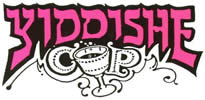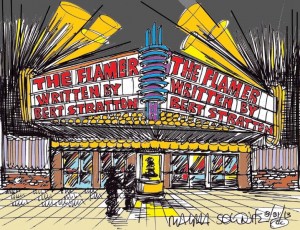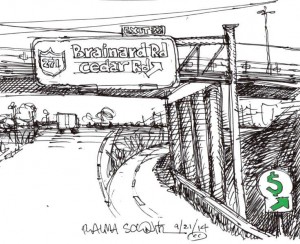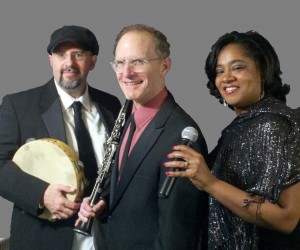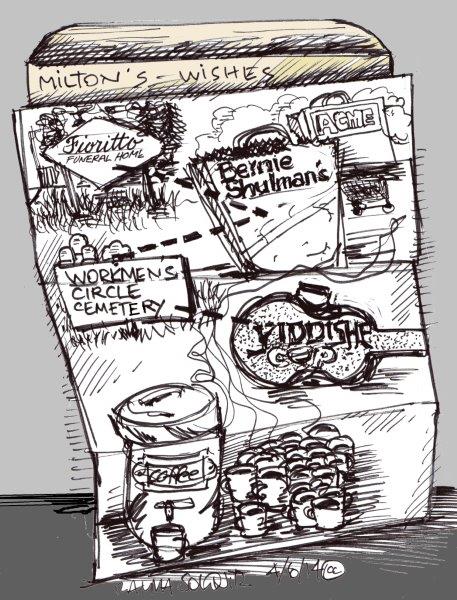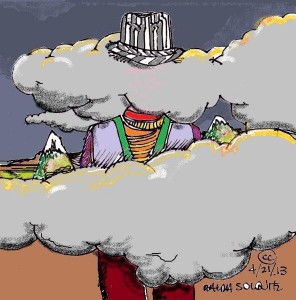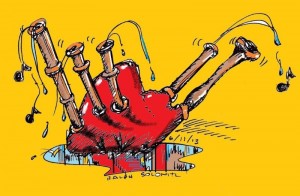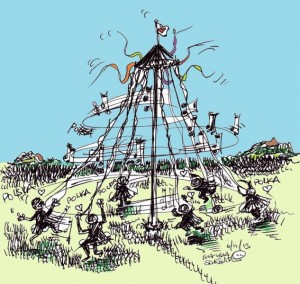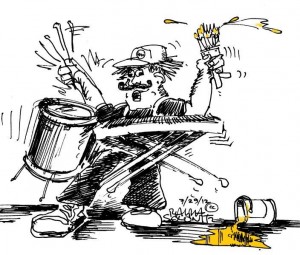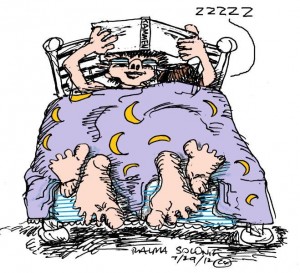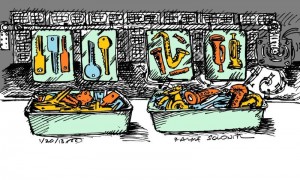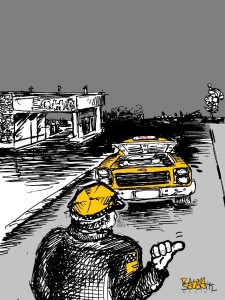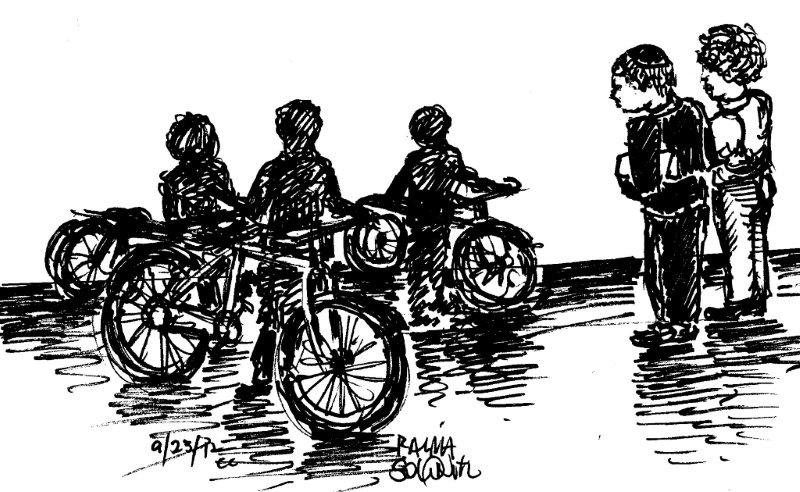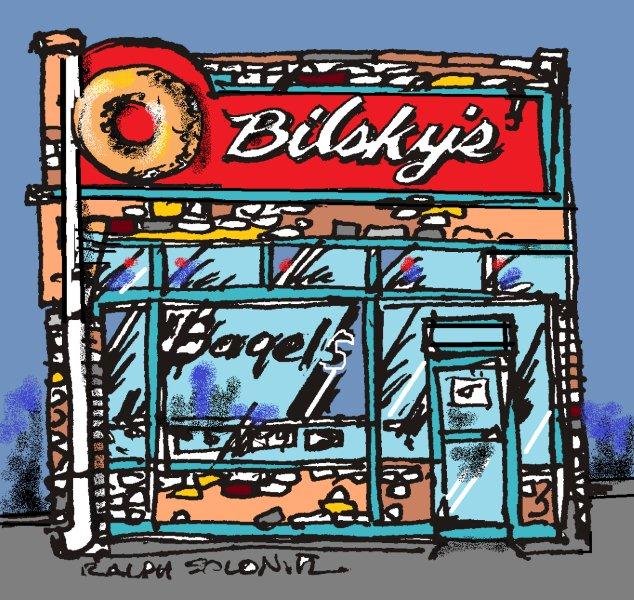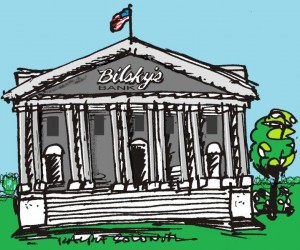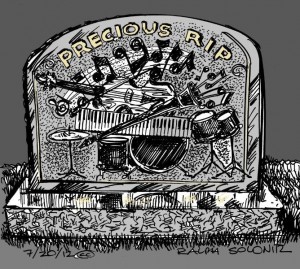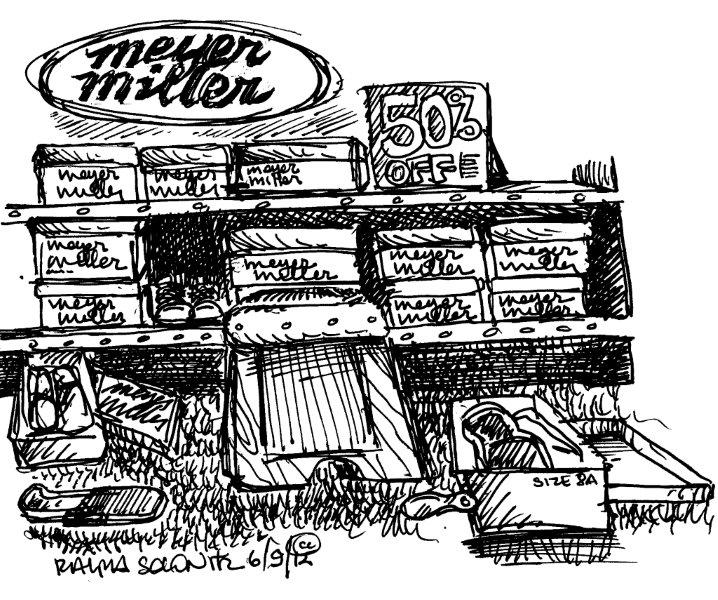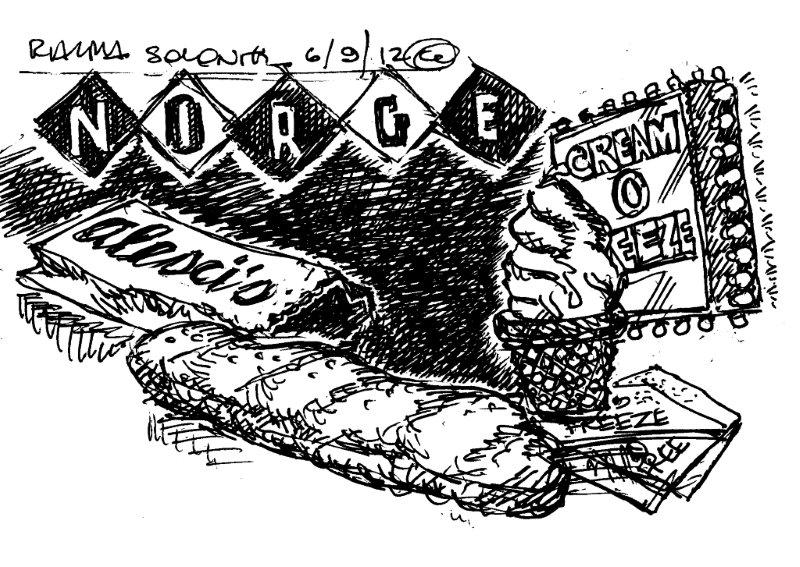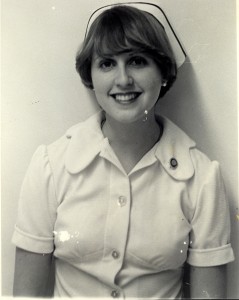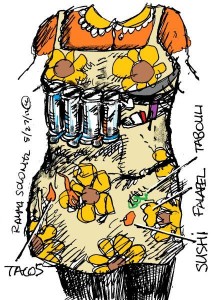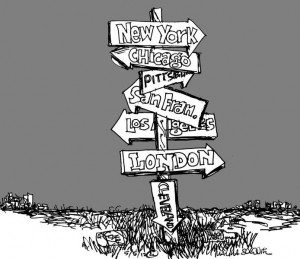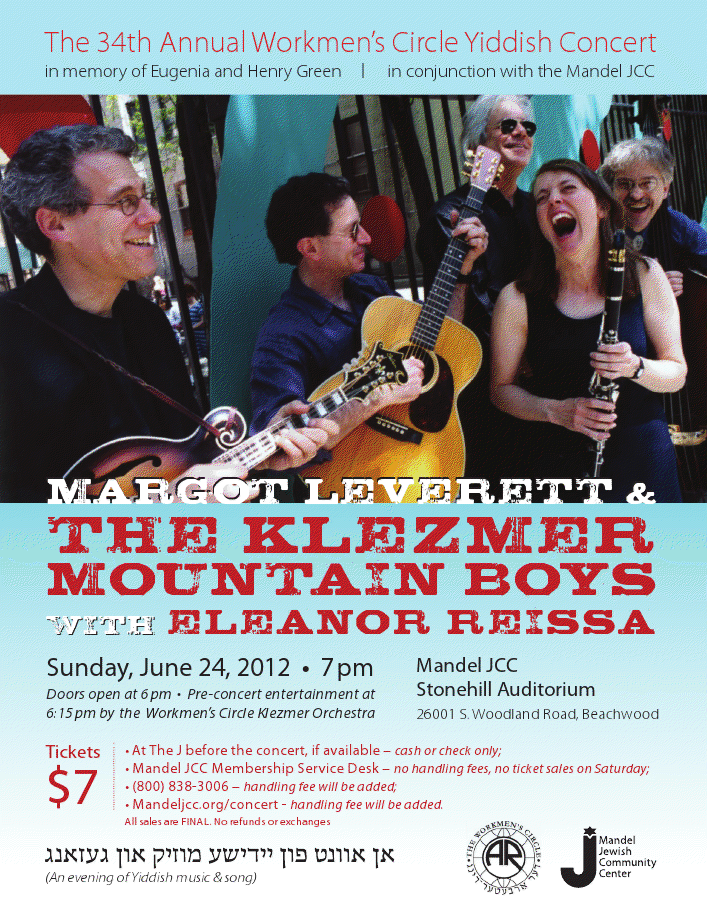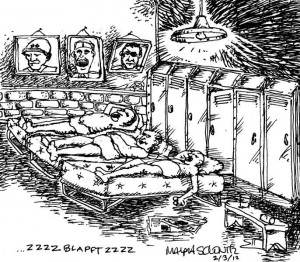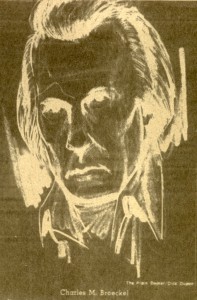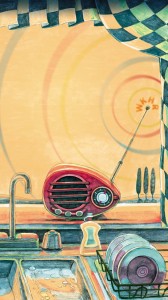Category — Cleveland, Full
MLACHAK, MLOTEK AND HRIBAR
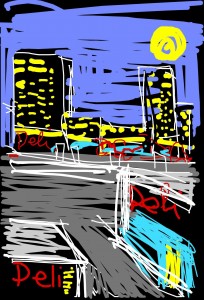 1. Norman Mlachak was a Cleveland Press reporter. I didn’t know him but knew of him. He grew up over a deli at E. 140th Street and Aspinwall Avenue. Every old-timer in Cleveland grew up over a deli, or near one. Nobody had a car, so there were a lot of delis. You bought food almost daily. Mlachak sometimes wrote nostalgic pieces for The Press. His neighborhood was Collinwood. He wrote about Fisher Body, Eaton Axle, Kuhlman Car Co. and the Collinwood Railroad Yards. He died in 1984.
1. Norman Mlachak was a Cleveland Press reporter. I didn’t know him but knew of him. He grew up over a deli at E. 140th Street and Aspinwall Avenue. Every old-timer in Cleveland grew up over a deli, or near one. Nobody had a car, so there were a lot of delis. You bought food almost daily. Mlachak sometimes wrote nostalgic pieces for The Press. His neighborhood was Collinwood. He wrote about Fisher Body, Eaton Axle, Kuhlman Car Co. and the Collinwood Railroad Yards. He died in 1984.
2. I went to high school with Helene Mlotek, who is probably related to Zalmen Mlotek, the New York klezmer macher. Aren’t all Jewish Mloteks related? Helene and I weren’t in any of the same classes.
3. Mary Lou Hribar grew up in and around Fritz’s Tavern, a polka hangout on E. 185th Street. Her father, Fritz, was inducted into the Cleveland Style Polka Hall of Fame, under the category “proprietors.” I once met Mary Lou at a Shaker Heights party and haven’t seen her since. Fritz died in 2001.
4. I was at Claudia Hlebcar’s wedding . . .
OK, enough. Thank you for your patience.
— Bert Ptacek
—
Irregular Passover Humor:
April 1, 2015 5 Comments
MY SHOW BIZ LUNCH
IN CLEVELAND
I had a show biz lunch at Corky & Lenny’s. The lunch was Hollywood-style, not Hollywood. Bert Dragin, the owner of a furniture store chain, was looking for a movie script. (This was in 1980. C&L’s was still at Cedar Center.) Dragin said to me, “I’ve got money. Everybody will talk to me in L.A. Right now I have something in the Best of the New York Erotic Film Festival.” He suggested I write a screenplay about a fire at a gay nightclub in Atlanta. Not my thing, sorry.
Dragin sold his Name Brand Furniture stores and moved to Hollywood to make movies. He produced Suburbia (1983), and directed Summer Camp Nightmare (1987) and Twice Dead (1988).
I wrote a screenplay, The Flamer, about a bar mitzvah party where several kids got burned to death by playing with sterno. [This paragraph is fiction. The rest is true.]
Dragin ran a tab at Corky & Lenny’s, which he probably paid monthly. He acted in his TV ads for the furniture store. “You heard of Erotic Salad?” he said. “It’s got a soft-X rating.”
“No.” That’s as close as I got to Hollywood.
March 4, 2015 6 Comments
MACHERS ON THE ROOF
Howard Metzenbaum was the big name in my father’s generation. Metzenbaum made millions in parking lots, and eventually became a U.S. senator. My father and Metzenbaum were born the same year, 1917, in Cleveland. My dad didn’t know Metzenbaum but enjoyed following his career.
Metzenbaum, in his later years, owned a condo at Three Village, the holy of holies for upscale living in Cleveland. The building went up in 1978 near Cedar Road at I-271. The Three Village condo development was wooded and secluded. My parents lived nearby, at the Mark IV apartments (now called the Hamptons). I don’t know why my mother went to apartment living from a colonial in South Euclid. She was a gardener, and then suddenly she was doing tomatoes in pots on her Mark IV balcony. My parents liked brand-new housing; they weren’t keen on used. Everything had to be shiny and new, maybe because they grew up in poverty.
Across from the Mark IV was Acacia on the Green — a step up, rent- and prestige-wise. Next to Acacia was Sherri Park, a step down. Across from Sherri Park was Point East, a step up from Acacia but down from Three Village. These buildings all went up in the 1970s and were popular with my parents’ generation.
My parents never went inside Metzenbaum’s building. I did. I visited a friend who bought a condo in Three Village. Metzenbaum was long gone — dead as of 2008 — and this was 2014. The building’s buzzer directory read Maltz, Mandel, Ratner, Risman, Weinberger and Wuliger (among others). Some of the condos were 7,500 square feet.
Maltz, Mandel, Ratner . . . Maybe you have to be an old Cleveland Jew to appreciate that. If you’re not an old Cleveland Jew, and have read this far, please explain.
Buzz. Come in.
—
The Klezmer Guy Trio performs at Nighttown, 7 p.m. Wed., Feb. 25. An evening of social commentary, plumbing tips and music. $10. 216-795-0550. Alan Douglass, piano and vocals. Tamar Gray, vocals. Klezmer, soul and standards. I’ll do prose blurts and play clarinet.
February 11, 2015 7 Comments
A FUNERAL WITH ALL
THE TRIMMINGS
The letter is from Milt — a friend of my parents — to his kids.
May 15, 1990
Dear Children,
In 15 days I’ll be 71.
As you know, I’m not religious, but I do like a good party.
About my funeral: Use the gentile funeral home, Fioritto in Lyndhurst, to deliver my body to the Workmen’s Circle Cemetery. Just bury me. Invite some family and friends. No rabbi! I’ve never gone to synagogue, so don’t start with that now.
Pick a convenient Sunday afternoon to throw a memorial service at the Workmen’s Circle hall on Green Road. There is plenty room, a loudspeaker, and a kitchen. Anybody who wants to speak, can speak. Except Bernstein.
I want a nice sendoff: trays, Scotch, music, dancing, food, coffee, pastry, wine and cold beer. Whiskey too. Hire a klezmer band — Bert Stratton’s band. (Bert is Julia and Toby’s son.) But remember, one hour of klezmer is enough.
Get the trays at Bernie Shulman’s at Cedar Center. They’re good and cheap, but you have to pick up the goods yourself. Get pastries from Acme supermarket at Mayfield near Green. Their pastries are excellent and much cheaper than the Jewish bakeries.
I want coffee, lots of coffee; the Workmen’s Circle can make it by the gallon. And plenty of soft drinks and wine — good wine. No Champagne. And hire kitchen help.
Mom will say I’m nuts. She can stay home if she wants! This is what I want.
Love,
Dad
—
Footnote: Milt died 16 years after he wrote the letter. He ate a lot and never exercised and lived to 87. He had a graveside service with no band and no food. No hard feelings, Milt. All mourners received a copy of Milt’s brisket recipe at the funeral.
I slightly “enhanced” the letter. I added Except Bernstein to “Anybody can speak. Except Bernstein.” And I added “One hour of klezmer is enough.” Couldn’t help it.
“Milt” is a pseudonym. If Milt’s children want his real name here, they’ll let me know.
June 18, 2014 9 Comments
AMERICAN GREETINGS
“Cleveland is a hard town. I came near committing suicide when I lived there.” — Robert Crumb, American Splendor intro, 1986.
Crumb worked for American Greetings. My dad, Toby, worked there too.
Toby was at American Greetings before Crumb. My dad worked with Morry Stone, who eventually became a vice chairman. My dad didn’t like working for anybody, including Morry, so Toby left in 1954.
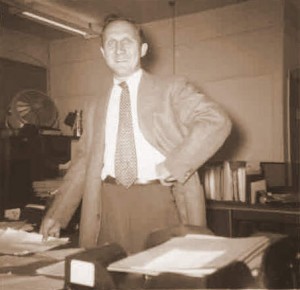
Toby Stratton, 37, at American Greetings, 1954
Everybody in Cleveland has worked at American Greetings, I think. Or tried to. I applied for a job at American Greetings in 1981.
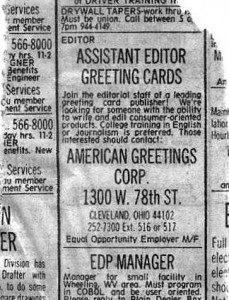
Plain Dealer, 1981
American Greetings had a Creative Building at West 78th Street. I didn’t even get called in for an interview. Maybe I wasn’t sick enough to write sick cards.
***
Robert Crumb again, 1996, Bob & Harv‘s Comics: “Cleveland is a city that has been ravaged by financiers and industrialists . . . its population abandoned to their fate, left to freeze their ass off, standing in the dirty winter slush, waiting for a bus that is a long time coming. Somehow they go on living.”
I haven’t lived anywhere else, so I can’t complain like Crumb. I went to college in Ann Arbor (which doesn’t count) and spent a few months in Bogota, Colombia, in my twenties.
Bogota was tougher than Cleveland. That, I can testify to. Bogota was rainy, gray, and headache-inducing from the high altitude. Cleveland was simply rainy, gray and slushy.
***
A pilot stood in a grassy field by the Bogota airport and said, “Tell your friends to throw their packs in back and we’ll be off.”
They weren’t my friends. They weren’t even Americans.
We climbed into the cargo section of the plane. “It smells like shit in here,” a Swiss girl said.
“This is Fish Airlines,” the pilot said. (Aeropesca.)
We landed in the Amazon a few hours later.
I ran into a college friend in the Amazon! I knew him from my freshman dorm. He said, “I scamp.” That meant he sold gems, coke, pot or counterfeit bills. “I’m going to reunite with my creators soon,” he said.
What?
“I’m going back to my parents.”
Adiós, amigo.
I tried to catch the ferry to Belem, Brazil. I waited several days in Leticia, Colombia, by the Amazon River dock, but the ferry didn’t arrive. I flew back to Bogota on the guppy/yuppie flight. (Guppies to Bogota, yuppies to the Amazon.)
In Bogota, I froze — even indoors. I wore two sweaters and socks-for-gloves in a small house I shared with a widow and her maid. I taught English at a nearby private junior high. For fun at night I read Cancer Ward . I also looked at photos of beauty queens from El Espacio and El Bogotano — the tabloids. My bedroom had doggy pictures on the wall, a toy cannon on the windowsill, and a crucifix over the bed.
For mental exercise I tried to reconstruct my high school schedule: first and second periods, PSSC Physics. What was third? What was PSSC? [Physical Science Study Committee.] I didn’t know many people in Bogie.
I heard Charlie Byrd play “Bogota” in Bogota. He was on a government-sponsored tour. Byrd en guitarra, con bajo y batería. (Byrd on guitar, with bass and drums.)
I went back to Cleveland after three months.
American Greetings. I couldn’t take Bogie. The major bookstore in Bogota was run by a Nazi, I thought. The owner was German, and I fabricated a fake bio, in my head, about him. I went to the Peace Corps office to borrow more paperbacks. I got Papillon, about a prisoner in Latin America.
I played blues harp for my English class. The kids loved it but the administration didn’t.
I had to leave. Bogie was un frío horrible (a freezing cold).
Crumb should write about Bogota. I want to hear his take on a real tough town.
—
Footnotes:
1. My Bogota adventure was in 1974.
2. I didn’t meet my college friend in the Amazon. I met him in Bogota. I remembered the encounter incorrectly. My friend straightened me out in Cleveland in 2013.
February 12, 2014 5 Comments
I BRAKE FOR ETHNICITY
1.
Yiddishe Cup has shared the stage with the Hungarian Scouts, Ukrainian Kashtan dancers, and Csardas, a Hungarian troupe. These groups draw fans to local festivals, and the dancers perform in difficult odd meters. Yiddishe Cup doesn’t draw many fans to these multicultural shows. The typical Jew doesn’t want to watch Ukrainians, Poles, or Hungarians dance.
At one festival, some of the folk dances had sappy English titles, like “My Little Cherry Tree” and “I Love You, Shepherd Boy.” I took the printed program home and looked up the real titles:
“Tylko We Lwowie” (Let’s Get Out of Lviv)
“Frogisic Sie Pani” (My Bagpipes are Soggy)
“Jaz Pa Ti” (Dad is Tipsy)
“Pytala Sie Pani” (Pierogis With Butter, Senator)
“Llactosi Nyasa Pilsenioya” (I Hate Milk and Like Beer)
“Jak Szybko Hund Chwile” (Jacko’s Chili Dog Is Outstanding)
“Nasza Jest, Noc Tylko” (Not Tonight, Not Tomorrow.)
2.
I bought a raffle ticket for the St. Mary’s Church (Collinwood) fundraiser, Catholic Order of Foresters, Court #1640.
I bought the ticket from Stan. Stan’s father was Stan too. Stan — my friend Stan – got married at St. William’s Church, not St. Stan’s. (St. Stan’s church is Polish. Stan is Slovenian.)
 Stan’s wedding reception was at the big Slovenian National Home on St. Clair Avenue at E. 65th Street. Stan hired his uncle’s polka band. At the wedding, we danced Slovenian-style polka — not the same as Polish-style polka. (If you don’t know the difference, please see Harvey Pekar’s “Polka Wars” American Splendor, issue #16.)
Stan’s wedding reception was at the big Slovenian National Home on St. Clair Avenue at E. 65th Street. Stan hired his uncle’s polka band. At the wedding, we danced Slovenian-style polka — not the same as Polish-style polka. (If you don’t know the difference, please see Harvey Pekar’s “Polka Wars” American Splendor, issue #16.)
Yiddishe Cup can play Slovenian! We’ve done Yankovic’s “Just Because” and “Blue Skirt Waltz,” and some charts from polka musician Joey Tomsick.
I won $20 in the St. Mary’s raffle. I haven’t seen the money yet.
Slovenians are tight with a buck. That’s their in-group reputation. Amongst themselves, Slovenians brag about their frugality, and they like to trash Lithuanians, who are even tighter. Stan told me all this.
The St. Mary’s Church raffle was three years ago. Stan, you owe me $23 — that’s $20 plus interest. Pay up, Stan. Any Stan.
September 25, 2013 6 Comments
SEIGER’S RESTAURANT
The cops at the Sixth District police station in Cleveland considered me a hippie spy from the Heights. But when I told the cops I was a Seiger (“My uncle owned Seiger’s Restaurant on E.118th and Kinsman”), the cops warmed up to me. The cops — the older ones, the bosses — all knew Seiger’s Restaurant.
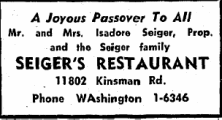
Cleveland Jewish News, 1968
Seiger’s Restaurant was a Damon Runyon casting hall on Kinsman Road. All manner of hustlers, cops, businessmen and shnorers (beggars) hung out there. The shnorers were Orthodox Jewish tzedakah (charity) collectors who had their own booth in the back.
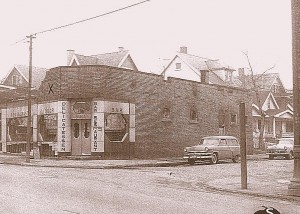
Seiger’s, 11802 Kinsman Rd., 1957
My Great Aunt Lil Seiger served the shnorers kosher food from her apartment, which was at the back of the store. The shnorers wouldn’t eat the non-kosher food from the restaurant. The deli was kosher-style, not kosher. “We served the rabonim [the rabbis] on special china and silverware, milchig [dairy]’,” Lil’s son Danny said.
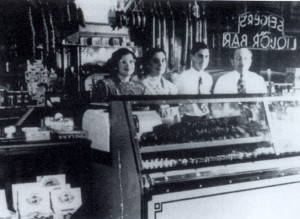
Seigers: Audrey (daughter), Lil, Danny (son) and Itchy, 1948
Rabonim — and cops — ate well at Seiger’s. Nobody ever got a ticket for an expired parking meter, and sometimes cars were parked two-lanes deep on Kinsman. “I couldn’t even spend a nickel in Seiger’s,” retired cop Bill Tofant said.
Itchy Seiger, my great uncle, was the owner and chief kibitzer (glad-handler/talker). He had been a cloak maker in Galicia, Austria-Hungary. Itchy was the greeter. Aunt Lil did the cooking, except the breads and strudels, which she bought.
There was a party room, seating about 65, in the basement. The matchbooks read: “Seiger’s Restaurant, Delicatessen, Barroom and Rathskeller.”
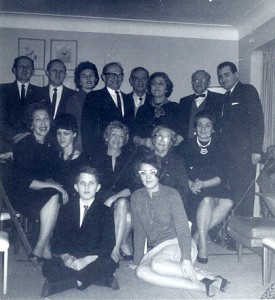
Danny and Itchy Seiger, back row, from R. Shiva for Anna Soltzberg, South Euclid, Ohio, 1964
I didn’t go to Seiger’s Restaurant often. My parents didn’t think Kinsman was the right direction for a Sunday drive. More often we wound up out east — the other direction — at the Metroparks.
Danny — my cousin — started showing up at Yiddishe Cup gigs in the 2000s. I asked him about the mini-feud between his father (my Uncle Itchy) and my grandmother, Anna Soltzberg (nee Seiger). Itchy and Anna had been half-siblings. (Enough with the genealogy, Klezmer Guy!) Danny said Itchy and Anna had had two things in common: sugar diabetes and iron wills.
My grandmother’s candy store — near Itchy’s deli on Kinsman — had frequently been “oyf tsoris” (badly off), and Itchy rescued it, Danny said.
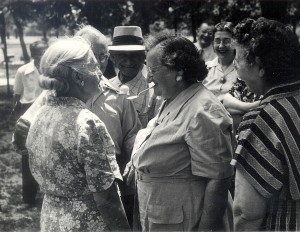
Anna Soltzberg, center, 1950s. Others unknown
“Everybody loved Itchy,” Danny said. Everybody but my grandmother, who complained about Itchy’s buy-out terms on her store. Later, my grandmother opened a candy store further east on Kinsman, near Shaker Heights.
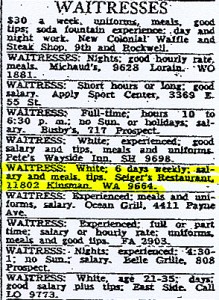
Cleveland Plain Dealer , 1947
“At the restaurant, there were two brothers, the Schoolers,” Danny said. “One, Joe, wanted a soft matzo ball. The other, Morty, wanted a matzo ball as hard as a baseball. Ma made both kinds. That’s how we thrived.”
Somebody should take Danny, age 80, and a video camera for a stroll down Kinsman. Walk Danny through the old neighborhood and into Seiger’s, which was recently a soul food restaurant. (Today it’s boarded up.)
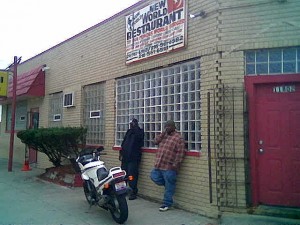
New World Restaurant, formerly Seiger’s, 2010.
The audio,
Danny: “This is where Ma made the mish-mash soup. She gave the recipe to Corky & Lenny’s. This is the counter where Jim Brown bounced a $10 check. I should have saved it for the autograph. This is where Oscar Schmaltz downed an industrial canister of soup. Oscar weighed 400.”
—
Footnote: Seiger’s is pronounced Sigh-ger’s (rhymes with High-gers) by Jews, and See-ger’s by cops. Seiger’s closed in 1968.
—
For relatives only . . . family photo above, taken at the shiva for Toby Stratton’s mother, Anna Soltzberg.
On floor, from L: Bert Stratton, sister Leslie.
Middle: Aunt Lil Soltzberg of Washington; Janice Bregman (wife of Marc Bregman); Aunt Pearl Bregman; Great Aunt Molly Mittman; Marcia Seiger.
Top: Uncle Milty Soltzberg, Toby Stratton, Julia Stratton, Uncle Sol Soltzberg, Great Uncle Sam Mittman, Aunt Lil Soltzberg of Delaware, Great Uncle Itchy Seiger, Danny Seiger.
(Sol Soltzberg, Milty Soltzberg, Pearl Bregman and Toby Stratton were siblings.) Marc Bregman — the son of Pearl Bregman — probably took this photo.
May 8, 2013 12 Comments
THE HEYMISH AND THE AMISH
I live near two large Amish settlements — Middlefield, Ohio and Holmes County, Ohio. I know some of the differences between the various Amish sects. Some Amish use battery-powered lights on their buggies. Some don’t. Some use the triangular orange “slow vehicle” sign, some don’t.
 Speaking of guys-in-black, I also know some very frum Orthodox Jews. I know what the crocheted yarmulke means versus the black hat.
Speaking of guys-in-black, I also know some very frum Orthodox Jews. I know what the crocheted yarmulke means versus the black hat.
I’ve only been around Amish and Jews once. I saw an Amish man in the lobby of Green Road Synagogue — an Orthodox synagogue in Cleveland. I said to myself, “I’m wrong.”
This “Amish“ guy was probably a hipster Jew trying to look Amish, with a wide-brim hat, beard, no mustache and a vest. Like Solzhenitsyn.
I saw 15 Amish women in blue dresses and white bonnets come out of the kitchen. They carried parfaits on trays.
Then I saw a horse and buggy at the side door. (How does a horse and buggy get to suburban Beachwood? By truck.)
Solzhenitsyn stacked bales of hay in the temple lobby and brought in chickens. He was John, an Amish from Middlefield, and he worked for an Orthodox Jew who owned a mattress factory and was hosting a sheva brochas (post-wedding dinner). Yiddishe Cup played the dinner. We played our usual repertoire of Yiddish, Hebrew and klezmer. I asked the Amish buggy driver what he thought of the music. He said, “It sounds like Mozart.” Maybe because of the violin?
The man stacking the hay said some Amish in Ohio play harmonica — the 10-hole diatonic model. “That’s all, for instruments,” he said. “Other instruments [like flute, guitar] might lead to forming a band.” A Jewish joke?
The rabbi jokingly asked if Yiddishe Cup knew any Amish songs. We tried “Amazing Grace.” Probably a first for Green Road Synagogue. The Amish liked the song. We also played a Yiddish vocal, “Di Grine Kusine” (The Greenhorn Cousin), which the Amish didn’t seem to go for. I thought they would like our Yiddish repertoire, since the Amish speak Pennsylvania Dutch.
Now I know: go easy on the Yiddish at Amish-Jewish parties.

Alan Douglass, Yiddishe Cup’s keyboard player, Green Road Synagogue, 2011
—-
The Klezmer Guy trio plays Nighttown, Cleveland Hts., 7 p.m. Tues., April 23. $10. Play it safe and make a res: 216-795-0550.
An evening of social commentary, plumbing tips, and song. As if Garrison Keillor was raised on pastrami.
Alan Douglass, piano and vocals; Bert Stratton, clarinet and prose; Tamar Gray, vocals . . .
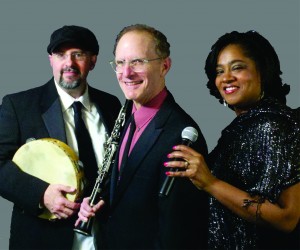
—
Next week “Klezmer Guy” posts up on Tuesday (April 23) instead of Wednesday. Just so I can remind you one more time about the April 23 Nighttown gig.
—
Mazel Tov to Sen. Jack Stratton (I-Calif.) for reaching his goal on Kickstarter. His band, Vulfpeck, hit the mark today.
Jack the Tummler . . .
April 17, 2013 1 Comment
MISSISSIPPI BUBBE AND
THE XYLOPHONIST
I look for musical yikhes (lineage/pedigree) wherever I can find it. My grandmother played piano at a white Baptist church in Yazoo City, Mississippi. Not bad.
This Mississippi bubbe — Ida Kassoff Zalk — had a brother, Earl Kassoff, in Cleveland. Earl was a drummer, xylophonist and house painter. He went by the stage name Earl Castle, and led bands in the 1930s and 1940s.
In the 1990s — when I first began looking for musical yikhes — I couldn’t find much info on Earl. I talked to a couple relatives. Earl didn’t leave behind sheet music or tune books. He died in 1969.
At a Yiddishe Cup gig, an elderly musician schmoozed with me. I asked him if he knew Earl Kassoff. Yes, he remembered Earl. The schmoozer was Harold Finger, age 77. He had made a living playing clarinet and sax during the 1930s and 1940s.
I took my tape recorder to Harold’s apartment and interviewed him. He said there were “four or five bands that got the Jewish work.”
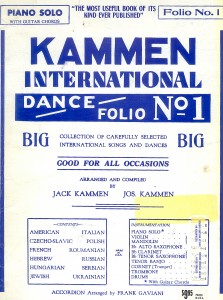 I asked, “What bands?” He didn’t remember the names. “What were the most popular Jewish tunes?” I said.
I asked, “What bands?” He didn’t remember the names. “What were the most popular Jewish tunes?” I said.
He said, “The songs from the Kammen Book. That was the big thing.”
The Kammen International Dance Folio, published in 1924, is still around. The Kammen book is to Jewish music what a sex manual is to sex. (Pianist Pete Sokolow makes this statement at most KlezKamp conventions.)
My Uncle Earl’s band did mostly “dance work” — American music, Harold said. Earl worked the downtown theaters, as well as the Golden Pheasant — a Chinese restaurant where Artie Shaw started.
Harold said he didn’t stick to the melody all the time. He did some “faking” (improvising). Now he played clarinet with a community orchestra. “I don’t do much jobbing anymore,” he said. (Jobbing is gigging.)
Harold died three years after the interview. I thought his kids might enjoy the interview tape, from 1992, so I called a Finger relative and left a message in the mid-1990s.
I didn’t hear back.
The relative should have called! Harold’s wife was on the tape, teasing Harold about how he loved his saxophone more than her. Harold said, “What? I quit playing music for you!”
—
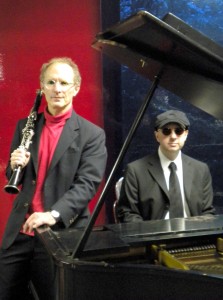 Michiganders, come to the Klezmer Guy show at The Ark, Ann Arbor, Feb. 15. 8 p.m. $20. Bert Stratton on clarinet and prose, Alan Douglass on piano and vocals, Gerald Ross on ukulele and Hawaiian lap steel guitar. Prose pieces will contain words such as “Ann Arbor,” “Michigan” and “Rudy Tomjanovich.”
Michiganders, come to the Klezmer Guy show at The Ark, Ann Arbor, Feb. 15. 8 p.m. $20. Bert Stratton on clarinet and prose, Alan Douglass on piano and vocals, Gerald Ross on ukulele and Hawaiian lap steel guitar. Prose pieces will contain words such as “Ann Arbor,” “Michigan” and “Rudy Tomjanovich.”
—
More on Mississippi Ida — my bubbe — later. Maybe not.
—
Yikhes update. Check out the latest from Jack Stratton’s band, Vulfpeck.
February 6, 2013 6 Comments
THE REAL WORLD (PARTS I and II)
PART I
I worked at a key warehouse as big as Home Depot. But just keys. The warehouse supervisor drove a golf cart.
I packed car keys. This was a summer job.
My dad worked in the front office.
My shift was about seven hours too long. I rested on my cart for massive breaks. Sarge, the warehouse supervisor, threatened to fire me, but he had a problem — my dad (aka the front office).
I told my father I wanted out of the job; I didn’t want any more money; I didn’t want a car; I didn’t want a UAW card. I had several thousand dollars from my bar mitzvah money. Let me go. I could be in Barcelona in a minute.
But I was stuck in the warehouse. Big presses stamped out car keys. Kaboom.
A band instrument factory was right next door. Why couldn’t my dad work there? King Musical Instruments. King had an employee who stood at the end of the assembly line and blew saxes all day.
Next time around, work at King, Dad.
PART II
The taxicab supervisor, smoking a stogie, asked, “Where’s Charity Hospital?”
“I don’t know, ” I said.
“Where’s the Federal Building?”
“Ninth Street.”
“The Pick-Carter Hotel?”
“I don’t know.”
“The Hollenden House?”
“Downtown — St. Clair.”
“People want to know where their hotel is,” he said.
Fair enough.
But hired me. Yellow Cab.
I drove welfare recipients with vouchers to hospitals, and workers to Republic Steel Works #4. I didn’t drive many rich people; I thought I was going to drive rich people, but it was poor people.
I picked up a fare downtown. The customer said, “Severance Hall.”
“Are you Claudio Abbado?” I asked.
“How do you know!” he said.
I knew because I had seen hi’s picture in the morning paper.
I stopped at my neighbor, John, afterward, and told him I had just driven a famous person. I said, “He’s a conductor from Italy.”
“Why did he come here?” John said. John’s favorite expression was “Cleveland is the armpit of the nation. ” Put that slogan on your cab door. This was 1970.
Taxi driving ultimately didn’t agree with me. A cabbie told me to carry a bat. He said, “A bat isn’t a concealed weapon. It’s legal.”
I had a low batting average.
My cab stalled at Fairmount Circle. The engine smoked. I left the cab and hitched back to the Noble Road garage.
The supervisor said, “You mean you left your cab, son?”
“I knew I could get back here. ”
“You mean you left your cab unattended?”
“Yes.”
December 12, 2012 No Comments
AFRO-SEMITIC ENCOUNTER
I’m not Orthodox, but I can walk the walk. Walking is a major part of my religion.
Last week my wife, Alice, and I walked home from Rosh Hashanah services. We were at Altamont and Compton roads, in a mostly black section of Cleveland Heights — close to a mostly Orthodox neighborhood.
Three black boys pulled up on bikes. The boys were out of school because Cleveland Heights closes on Rosh Hashanah.
I had on a yarmulke. I like to wear a yarmulke in public once in a while, just to “out” myself.
D’Shawn, leaning on his handlebars, said, “You Jewish?”
“Yes,” I said.
He turned to Alice. “You Jewish?”
“Yes.”
“Total Jewish?” he asked.
“Yes,” my wife said, smiling. She knew D’Shawn. Alice teaches gym in the local public school and knows a lot of kids. “Being Jewish is a good thing. The food is good . . .”
“You go to that building [synagogue] up on Taylor?” D’Shawn asked.
“No, we go to the big temple — the one with the dome — over there,” Alice said, pointing toward Euclid Heights Boulevard.
Alice wears slacks. She doesn’t wear a wig. She doesn’t look Orthodox. (She isn’t — not by a long shot.)
“You breaking Armish?” D’Shawn said.
I said, “Breaking Armish? Did you say ‘breaking Armish’? What’s that mean? You mean ‘breaking Amish’?” Either way, it made no sense to me.
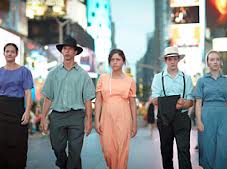
"Breaking Amish"
Breaking Amish is a reality TV show about Amish kids breaking loose in New York. The first episode was on last week. (I Googled this info when I got home.)
D’Shawn apparently thought Alice was “breaking Armish” because she doesn’t look like a member of the local black-hat Orthodox crowd.
—
Side B — “Beer and Coconut Bars,” a classic blog post — is below this video.
This clip may be the most innovative vid on earth. By Jack Stratton. Michael Brecker (on electronic wind instrument) jams with Uncle Milty Friedman.
—
SIDE B
A version of this post ran on CoolCleveland.com last year (12/6/11). This version has more illustrations and pics!
BEER AND COCONUT BARS
My dad admired bankers. In my dad’s pantheon of great Cleveland Jewish families, the number one clan was the Bilsky family, who made bagels, then went into medicine (son #1), bowling alleys (son #2), and started a bank (son #3). My grandmother used to say “The Bilskys make big bagels out of little bagels.”
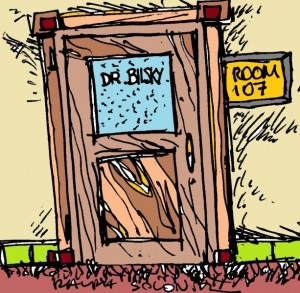 Scott Bilsky, 37, called to book Yiddishe Cup for a Fairmount Temple event. He said 12 Bilskys would be at the temple party.
Scott Bilsky, 37, called to book Yiddishe Cup for a Fairmount Temple event. He said 12 Bilskys would be at the temple party.
Dr. Harold Bilsky, son #1, had liked Yiddishe Cup. Harold had grown up with my dad on Kinsman Road. Harold wouldn’t be at the gig. He died in 2007. Leo, son #2, wouldn’t be there either. He died in 1998. I asked Scott, “What about the banker?”
“That’s my grandfather Marvin,” Scott said. “He’ll be there.” Marvin is 90.
At the gig, I talked to Marvin during our breaks. He told me, “Everything I ever did began with a B — baker, banker and builder. Plus brewer.”
That “brewer” part was news to me — Bilsky a brewski?
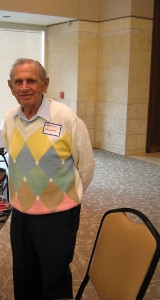
Marvin Bilsky, 2011
“My father bought Cleveland-Sandusky Brewing in 1955,” Marvin said. “There were very few Jews involved in the brewing business then. In the 1960s, Israel came to us for brewing tips and equipment.”
Marvin said there were only four other Cleveland breweries in the 1950s: Carling’s from Canada (“very nice people”); Standard Brewing; Erin Brew, Irish; Leisy’s, German; and Pilsener’s P.O.C., Czech. Bilsky’s brewery bottled Gold Bond beer and Olde Timers Ale.
“We all used to meet on Mondays. I didn’t have any trouble with anybody,” Marvin said.
The last local brewery in town was Carling, which closed in 1984. National breweries killed off the locals.
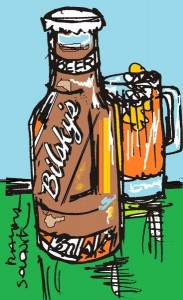 My father never taught me about brewskis. He rarely drank; it would have interfered with his worrying. (Old Jewish joke.) I knew about Carling’s from old Cleveland Indians’ radio ads. “Hey, Mabel, Black Label . . . Carling Black Label beer.”
My father never taught me about brewskis. He rarely drank; it would have interfered with his worrying. (Old Jewish joke.) I knew about Carling’s from old Cleveland Indians’ radio ads. “Hey, Mabel, Black Label . . . Carling Black Label beer.”
Bilsky’s brewery was just a blip in the Bilsky biz history. The Bilsky business was Bilsky’s Bakery, which had started on Kinsman and moved to Cedar Center in 1948.
Who invented the Cleveland coconut bar?
That was the question I should have asked Marvin. My dad had loved coconut bars (and halvah). I should have asked.
 Marvin was in the phone book . . . .
Marvin was in the phone book . . . .
“Marvin, this is Bert Stratton from Yiddishe Cup, the klezmer band.”
“Thank you for the concert yesterday. You did as well as you could,” he said. “No, seriously, we enjoyed it! To answer your question, I’ve always said my father invited the coconut bar, but — and I have to tell you this — I went to Sydney, Australia, and I went down into the subway there. They have a small subway system. They had coconut bars down there! They didn’t call them coconut bars. [Australians call them lamingtons, says Google.] Where did they get them? Maybe from England. Australia used to be part of England.”
“Marvin, I have a friend, my age — his grandfather was Kritzer’s Bakery on Kinsman — my friend says his grandfather invented the coconut bar.”
“It was my father!” Marvin said, laughing. “Who knows.”
I called my cousin George Becker, whose father had owned Heights Baking on Coventry. George said his father didn’t invented the coconut bar.
Yippee, one less Coconut Bar King to contend with.
Former Clevelander Scott Raab wrote in Esquire (July 2002): “Ask for coconut bars in any Jewish bakery from New Jersey to Los Angeles and you’ll get some version of this: ‘So, you’re from Cleveland . . . We don’t have ’em.’”
September 27, 2012 10 Comments
A LOVE SUPREME
The Jazz Temple was a music club in a former Packard showroom at Mayfield Road and Euclid Avenue. Coltrane played there. Dinah Washington too. 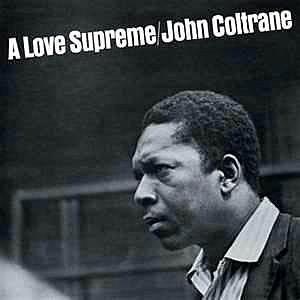 Everybody played there. The Jazz Temple was in business from 1960 to 1963.
Everybody played there. The Jazz Temple was in business from 1960 to 1963.
I passed the Jazz Temple weekly on my way to Sunday school at The Temple, a Reform synagogue in University Circle, Cleveland.
Rabbi Abba Hillel Silver was the head rabbi at The Temple. Rabbi Silver was very prominent; he spoke at the United Nations, advocating for the establishment of the state of Israel. Rabbi Silver’s son, Danny, was the assistant rabbi. He played football at Harvard and blocked hard for his dad.
The Sunday school kids at The Temple were mostly from Shaker Heights. One kid got a ride in a limo to shul. The driver wore a chauffeur’s cap.
I couldn’t grasp how temple — the word — fit into a non-Jewish setting, like in “Jazz Temple.” Was Jazz a religion too? (Give me a break. I was 10.)
Years later, I met a couple ex-beatniks who had been old enough to go to the Jazz Temple in the early 1960s. They had heard Trane and Ella.
The Jazz Temple was blown up in 1963. Somebody didn’t like the club, or the owner, Winston Willis, a controversial black businessman.
At The Temple, the religious-school kids would attend the last part of the service and hear the sermon. Rabbi Silver looked like God and talked like Him.
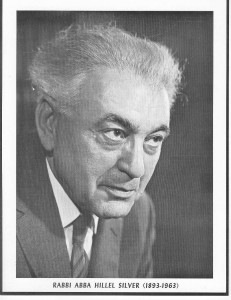 Today, at The Temple East in Beachwood, there is an Abba Hillel Silver memorial study. The rabbi’s desk is laid out like he just stepped out for lunch. He died in 1963.
Today, at The Temple East in Beachwood, there is an Abba Hillel Silver memorial study. The rabbi’s desk is laid out like he just stepped out for lunch. He died in 1963.
Rabbi Silver: Live at the Jazz Temple. Interesting.
John Coltrane: Live at The Temple. Another possibility.
A love supreme . . .
A love supreme . . .
—
SIDE B
PRECIOUS
In the arts, if you’re precious, you’re bad. Precious is the worst thing. Precious means you’re dainty and overly refined.
A friend (a former music critic) called all college a cappella music precious.
Harvey Pekar called Willio and Phillio — the Cleveland music-comedy duo — precious. (Willio and Phillio was around in the 1980s.) Willio and Phillio was precious — their stage name for sure. Willio (Will Ryan) went out to Los Angeles to work for Disney, and Phillio (Phil Baron) became a cantor in L.A. They were good, and probably still are.
Yiddishe Cup is precious occasionally. The musicians say “oy vey” too much on stage. I’ve tried to get my guys to stop. I can’t.
Peter Laughner, a Cleveland rocker, died from drug abuse and alcoholism at 24. He killed himself, basically. (This was in 1977.) He was not precious. He was dead — and funny — about art. He was in the Pere Ubu underground before Pere Ubu was famous.
Suicide doesn’t appeal to me for two reasons: 1) My wife would kill me if I tried it. 2) I want to attend my kids’ weddings and eventually meet my grandkids-to-be.
“Precious” is OK for grandkids. (“Grandkids” is precious.)
—
SIDE C
New construction — Side C — for Michiganders. . .
THE LODGE
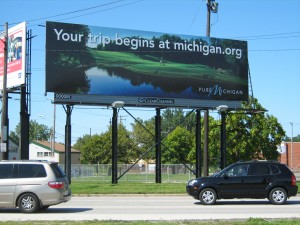
Chester Ave., Cleveland, 2011
I drove to Rochester, Michigan, which is not as cool as Rochester, New York, but it does have a small-town charm.
I’ve seen Father Coughlin’s former church in Royal Oak, Michigan.
I’ve been to Detroit many times.
My wife, Alice, said, “Detroit has very long roads.”
She probably meant Woodward, Gratiot and Telegraph.
Detroit also has the Lodge. Elmore Leonard mentions the Lodge in his books, like, “The gambling casino, Mutt, you can’t fucking miss it, over by the Lodge freeway.”
A couple Cleveland freeways and bridges have names, like the Bob Hope Memorial Bridge, but nobody ever uses the names.
I stayed at a hotel near the Silverdome, which looked like a big pillow. (The stadium did.) A Detroiter told me the Silverdome sold for about $200,000. A stadium for the price of a California carport.
Who was John C. Lodge? Probably a labor leader. [No, the mayor of Detroit in the 1920s.]
Detroit is like Cleveland. Detroit has the Eastern Market; Cleveland has the West Side Market. Detroit has downtown casinos. Now Cleveland has a downtown casino.
Metro Detroit has a few more Jews than Cleveland. And probably more Arabs, Poles and Ukrainians. And more blacks.
People who wear Tiger caps are cool, as are Indians cap wearers.
What about Berkley, Michigan? Is that worth a visit?
Elmore Leonard eats at the Beverly Hills Café. I wonder if that’s part of the Beverly Hills Café chain, or an independent restaurant in Beverly Hills, Michigan.
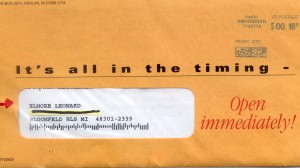 I wonder if Elmore Leonard spends his winters in Detroit. I bet he doesn’t. He writes a lot about Florida.
I wonder if Elmore Leonard spends his winters in Detroit. I bet he doesn’t. He writes a lot about Florida.
I have some Elmore Leonard junk mail.
City Primeval: High Noon in Detroit. That’s worth reading.
Maple means 15 Mile. Big Beaver is 16 Mile.
What about Oakland University? Does the university have Bobby Seale barbecue sauce in the cafeteria?
I live only three and a half hours from Berkley, Beverly Hills and Oakland.
—
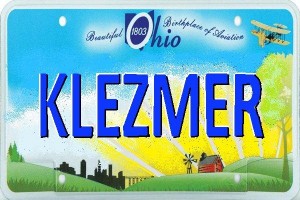 Yiddishe Cup pulls into Motown Sunday. See us at Cong. Beth Shalom, Oak Park, Mich.,
Yiddishe Cup pulls into Motown Sunday. See us at Cong. Beth Shalom, Oak Park, Mich.,
2 p.m., Sept. 9. Open to the public. Concert info here.
September 5, 2012 7 Comments
TICKTIN
Harold Ticktin, 85, writes a weekly column for the Cleveland Jewish News on Yiddish. For instance, he writes about what balabuste means, or balegole. (Female boss and wagon-driver.)
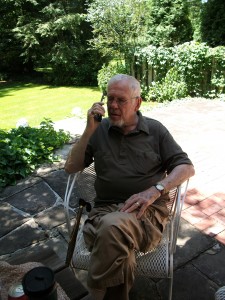
Harold Ticktin, Shaker Heights, 2012
Also, Harold occasionally reflects on early-20th century leftist politics for magazines such as Jewish Currents.
I asked Harold for a couple Yiddish translations. I was in his backyard in Shaker Heights. I wanted to know Yiddish permutations on “How’s it going in?” — everything from “How are you?” to “What’s happnin’, man?” Ticktin gave me some options, none perfect, and concluded, “Translation is treason.”
He continued, “Listen, there was this pharmacist who did a big business in trusses – you know what a truss is?”
“Yes.”
“The pharmacist’s slogan was Ayer kile iz undzer gedile — your hernia is our pleasure. I told the pharmacist that was a horrible translation. He told me to come up with a better one. I said, ‘Your rupture is our rapture.’ Wouldn’t that make a great bumper sticker for an abdominal surgeon?”
“Did you make that up — your rupture is our rapture?” I said.
“That’s a true story. It’s an absolutely true story.”
Ticktin is a retired workers’ comp lawyer. He can speak decent Italian, French and Spanish, as well as Yiddish. One of his favorites translations is All Screwed Up, he said, for the Lina Wertmuller film Tutto a posto e niente in ordine, which literally means “everything ready, nothing works.” “You don’t translate, you render,” Ticktin said.
Ticktin continued, “James Thurber ran into a woman in Germany who said, ‘I love your work in German.’ Thurber said, ‘Yes, it’s true, my work loses something in the original.’”
Ticktin lives three miles from his old stomping grounds — the Kinsman neighborhood. Harold grew up on E. 154th Street, Cleveland, hard by the Shaker Heights-Cleveland line. He said Shaker had been “hakodesh hakadashim [the Holy of Holies] — the other.” Shaker had been nearly unapproachable, like the inner sanctum at the Temple in Jerusalem. “I didn’t know anybody in Shaker. Maybe one person.”
Kinsman Road was Ticktin’s main artery. He said, “I walked [down Kinsman] from 154th to E. 140th to observe the class struggle. My father was a Yankee. He came over here when he was two. He liked baseball. What did he know about politics? He knew this: Roosevelt was great and Hitler was bad.”
At E. 146 Street, Harold met Peter “The Brain” Ostrovsky. “I was converted to communism by Ostrovsky on the train to the Philly Navy Yard in 1946. I was converted just west of Pittsburgh.”
The upshot: “I saw the God who was to fail, though I still have a warm spot for Marx, for his Lincoln correspondence,” Harold said. “I’m a member of the extreme center now.”
I wanted Ticktin to give me a tour of Kinsman — the proste, working-class Kinsman of his youth. “How about it?” I said. “Now?” Ticktin agreed. We got in my Lolly the Trolley — my Mercury Sable.
***
Stop 1. Woodhill Park at E.116th. Ticktin: “I remember when I was 10 years old [1937] at Woodhill. It was a tremendous swimming pool. Everybody got out of the water. Why? Because Frieda Katz, a geferlikher (dyed-in-the-wool) communist took a swim with a black kid. The place cleared out. This was Frieda Katz from Katz’s Deli at E. 147th and Kinsman.”

Formerly Seiger's
2. Seiger’s deli at 118th. “I knew Hymie Seiger best. He went off to yeshiva in junior high. He just left. I didn’t even know what a yeshiva was.”
3. E. 121. “This was where I attended my one Seder as a child. On that street. Very important.” Ticktin eventually became president of his shul.
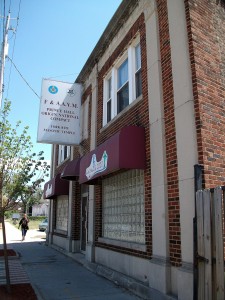
Council Educational Alliance building, now a Masonic hall
4. 13512 Kinsman, the Council Education Alliance. “The apex and GHQ [general headquarters] of my youth. The Communist Club met there.” It was a settlement house.
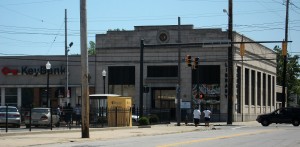
Cleveland Public Library - Mt. Pleasant branch
“In the 1936 election, the Communist Club painted ‘Vote Communist’ in blue on the library at E. 140th. The library had been a bank before. Some members of the club got mad because the graffiti was blue. They said, ‘We need to paint it red.’ Ostrovsky went back to re-paint it and got caught. He was defended by Yetta Land, who handled all the communists. I don’t think Ostrovsky was punished too severely; he was a juvenile.”
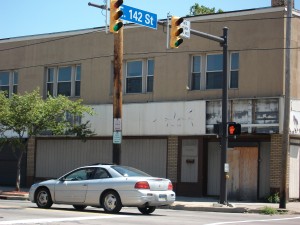
Formerly Spumoni's (middle store)
5. E 142 and Kinsman. “We called this place Spumoni’s. The real name was Giaimo’s — an ice cream place. The communists met across the street above the Woolworth’s, which is long gone.
“On Saturday nights all the single Jewish guys would hang out here at Spumoni’s and greet each other Marty-style, like, ‘Whadaya want to do, Marty?’ This went on up through the 1940s and 1950s.”
“What’s Marty-style.”
“Like Marty, the movie with Ernest Borgnine. You don’t remember it?”
“No.”
“Single Jews guys — and married Italians — hung out, to go out on the town. I always envisioned a cowering Italian wife in the kitchen back home saying, ‘Tony, when you gonna be home?’”
6. E. 154th / the Shaker Heights line. “Hakodesh — the other,” Ticktin said. “I was in New York once and stopped in at YIVO [Jewish Research Institute] for a list of places European Jews had vacationed before the war. I needed this for a speech in Yiddish. They asked me, ‘You mean intellectuals? Peasants? We’ll get back to you.’ They didn’t get back to me. A couple weeks later, I’m at a gathering of Jews and Poles in Cleveland, an American Jewish Committee meeting, and I meet the speaker, a prominent Polish Jew, Lucjan Dobroszycki, the editor of the Chronicle of the Lodz Ghetto. I ask him about vacation spots before the war. He looks at me and says, ‘This is the second time in two weeks somebody has asked me this question.’ End of the line, Lucjan Dobroszycki — don’t ask me how to spell that.”
7. I drive Harold Ticktin into Shaker Heights. Another end of the line.
—
The photos, above, are from 2012, except the former Seiger’s deli pic, which is from 2010. Seiger’s — later New World Restaurant — is now boarded up.
—
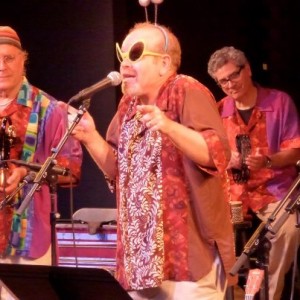 Yiddishe Cup plays a concert in Metro Detroit.
Yiddishe Cup plays a concert in Metro Detroit.
2 p.m. Sun. SEPT 9
Congregation Beth Shalom
Oak Park, Michigan
August 29, 2012 10 Comments
THE NOSTALGIA VORTEX
About half the people I meet in Cleveland are graduates of Shaker Heights or Cleveland Heights High. (I live in Cleveland Heights.)
The others are often out-of-towners. (“Out of towner” is anybody who moved to Cleveland within the last 30 years.)
I occasionally run into St. Ignatius and West Side grads too, but that’s not this story.
Cleveland Heights High grads like to reminisce about the Cedar-Lee neighborhood. Their nostalgia nexus is the Cedar Lee Theatre and what used to be around there . . . Mawby’s, Meyer Miller shoe store, Earth by April.
One Heights guy told me he learned almost everything in life by selling shoes at Meyer Miller as a teenager.
Meyer Miller’s co-owner was Cuppy Cohen.
The pool hall below the Cedar Lee Theatre was Wally’s.
Who cares? Heights people do.
Sid Abrams, a deceased freelance writer, wrote about Coney Island for the Cleveland Jewish News. He and the editor grew up near Coney Island. Two people read the Coney Island stories in the Cleveland Jewish News. Sid and the editor.
My nostalgia vortex is Mayfield Road, South Euclid. Mayfield Road was Italians plus a couple Jews, like me. My elementary school was on Mayfield, as was my high school, Brush. On my way home from elementary school, I would buy Italian bread at Alesci’s and hollow out the insides. My mother would say, “Where’s the bread?” as I handed her the crust.
West of Alesci’s was the Cream-O-Freeze; to the east, the Norge Village Laundromat. It took a village . . . Jay Drugstore, for baseball cards; Lawson’s, for Hostess cupcakes; Society for Savings, for uncirculated pennies.
Excuse me, I have to check the Sohio Jackpot winners list.
July 26, 2012 No Comments
ALICE’S RESTAURANTS
Pre-kids, my wife, Alice, and I ate out a lot. We mostly went to dives. That was our hobby. Dives as low as Krisplee on East 82nd Street and Euclid Avenue, and Albino’s at West 44th Street and Lorain Avenue.
At home, Alice cooked a lot of tofu. That’s why we ate out a lot.
We don’t go out much now. I can’t stand the long waits, the so-s0 food, the noise. I’m my dad.
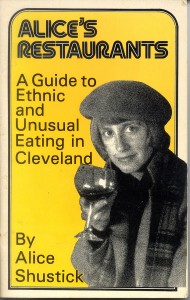 Alice published a restaurant guidebook, Alice’s Restaurants, in 1981. The book sold particularly well at the airport bookstore. Alice’s oddest recommendation was the cafeteria at Metro General Hospital. She liked the beef stroganoff and Viennese tort there. (Alice was a nursing student.)
Alice published a restaurant guidebook, Alice’s Restaurants, in 1981. The book sold particularly well at the airport bookstore. Alice’s oddest recommendation was the cafeteria at Metro General Hospital. She liked the beef stroganoff and Viennese tort there. (Alice was a nursing student.)
I liked Draeger’s, an ice cream place at Van Aken. I wasn’t into balanced meals.
Here are a couple recommendations from the book:
(Still around) Balaton, Corky & Lenny’s, Flat Iron Cafe, Mad Greek, Mamma Santa’s, Hot Dog Inn.
(Dead) Zosia’s, Gerome’s, Art’s Seafood, It’s It Deli, Vegetaria, Radu’s, Aurora, Draeger’s, El Charro.
When we had our first child, our eating out petered out. Alice wrote a baby book, but never published it. I can’t remember what the book was about, other than babies. Oh, it was The Bye, Bye Book — how to prepare your kid psychologically if you left town for a day or two.
Our kids — now grown — became foodies. Maybe we left them home too much. A lot of 20-somethings became foodies. A baby-boom friend described his grown kids’ religion as Foodism.
Alice — the original Foodist — sold street food. She never made a dime, but she made a name for herself. In the mid-1980s, Alice was the first to sell sushi rolls in Cleveland. This was at the Coventry Street Fair. Few locals knew what sushi was. Alice made vegetable rolls. She grossed well, but her expenses were high. She paid a Korean-American friend, Mike, to help. Mike lent an air of authenticity — not that he knew anything about sushi.
Alice did tabouli at the East 115th Street Fair. Tabouli was a loser. Why? It wasn’t that good. And a Cadillac with musicians playing in the trunk — next to Alice’s booth — was a lot more entertaining.
Alice sold falafel at the Coventry fair. She called that operation Queen Alice’s Falafel. We ate a lot of falafel because she was always tweaking the recipe. She did falafels for a couple years.
Alice is talking tacos lately. Our son Teddy is talking pad Thai.
Foodists.
—-
SIDE B
THE JEW OF HOME DEPOT
Carl Goldstein, a landlord friend of mine, wants to be a docent at Home Depot when he retires. He goes to Home Depot at least twice a day, six days a week. That’s more than 600 Home Depots visits per year. Carl owns and manages double houses on the East Side of Cleveland.
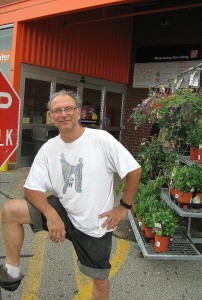
Carl Goldstein, 2011
He said, “Home Depot saved my life. Before they came to town, I used to go out to Builders Square on Wilson Mills. That was the ruination of my life. After Builders Square, I would take the freeway to DIY on Chagrin, and then to Seitz-Agin [hardware] on Lee. And I still wouldn’t have everything I needed!”
Carl worked at a plumbing supply store for seven years; he sold hot water tanks, boilers, Flushmates and plumbers dope. Carl’s father was a plumber in Flint, Michigan. Carl has a collection of Corky toilet flappers and other odds and ends in his truck. He gave me a Niagara water-saving shower head. ($5.13 from Woodhill Supply. Too specialized for Home Depot.)
I  bought more Niagaras. I have about fifty now. I switch shower heads when tenants move out. (Bad business to switch shower heads on current tenants.)
bought more Niagaras. I have about fifty now. I switch shower heads when tenants move out. (Bad business to switch shower heads on current tenants.)
Carl wants Home Depot to hold a storewide scavenger hunt. The first contestant through the Home Depot check-out line with all the correct items wins. “I’m a shoo-in,” Carl said. “Second place would be Marc Apple.”
“Marc Apple?”
“He’s a Cleveland Heights contractor,” Carl said.
There are two Jews of Home Depot in Cleveland.
—-
Read Max Apple’s The Jew of Home Depot and Other Stories. (Max Apple is not related to Marc Apple.)
Next: The Jews of Home Depot (Atlanta): Bernie Marcus and Arthur Blank.
—
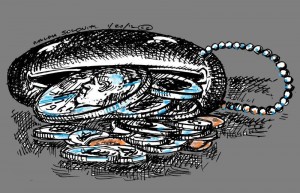 I wrote about Alice, hot weather and money at today’s CoolCleveland website.
I wrote about Alice, hot weather and money at today’s CoolCleveland website.
—
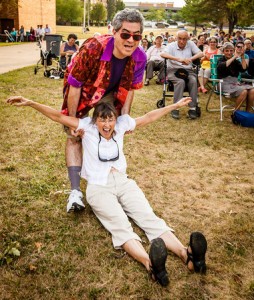 Alice and dance leader Daniel Ducoff on the front page of the Cleveland Heights Sun Press, 7/12/12. (Well-written article about Yiddishe Cup by Ed Wittenberg. Photo by Jim Olexa.)
Alice and dance leader Daniel Ducoff on the front page of the Cleveland Heights Sun Press, 7/12/12. (Well-written article about Yiddishe Cup by Ed Wittenberg. Photo by Jim Olexa.)
July 18, 2012 11 Comments
COOL CLEVELAND
My daughter, Lucy, is a corporate event planner in Chicago. She has done work for the president, Oprah, McDonald’s, Coke and Target. She has worked gigs from Turkey to Australia. Maybe I’m not allowed to say all this. (I’ll clear it with her.) She said to me, “We’re doing something [in Chicago] for Topshop. Do you know what that is, Dad? It’s a women’s fashion store from London. They want to bring in their own fashion-show coordinators from New York. They don’t trust Chicago.”

Lucy Stratton in Chi, Dec. 2007
Chicago is fourth — behind New York, Los Angeles and San Francisco — in American coolness, Lucy said. “They think we’re hicks.”
What do Londoners think of Cleveland? Do they think it’s in northern England? I think Cleveland is in northern England. [Yes, it’s a county near Scotland.]
Cleveland, Tennessee. Magic Chef makes stoves there.
Boston. That was a cool town once. In the early 1970s, young people headed to Boston. The town was popular because, for one thing, it had James Taylor . . . “[The turnpike was covered] from Stockbridge to Boston.” The Ohio Turnpike was covered from Youngstown to Toledo, but nobody noticed that.
New York wasn’t that popular in the 1970s. Chicago wasn’t either.
These days Chicago attracts young people from all over Big Ten country. Whenever I meet baby-boomers in Cleveland, I assume their kids are in Chicago unless told otherwise.
I like Pittsburgh.
“Keep Austin weird.” That’s so lame.
I would like at least one of my three adult children to move back to Cleveland. But I’m not twisting my kids’ arms. Cleveland ain’t happening, at least not like the Big Four (Chi, LA, SF and NY).
The Big Four gets old when you get old, kids.
Which city is number five? Minnie? Seattle? DC? Cleveland?
Cleveland. (I just polled myself.)
—
SIDE B
JEWS, GOD AND BAKERY
My challah purveyor is On the Rise Bakery in Cleveland Heights. I know the owner and some of the help.
I went there to put up a poster for a klezmer concert:
The cashier said, “We don’t do religious events.”
What?
I stammered, “It’s not religious. It’s the Workmen’s Circle. It’s secular. It’s bluegrass and klezmer.”
I wonder if the owner is against religion. I’ll have to ask him. I don’t think he is. He’s Jewish. I get along with him. The cashier said, “I’ll have to run it by the owner.”
I went back a week later, and the poster was up.
What if the poster hadn’t been up? I would have had to move my challah biz to another bakery — one with “religious” flyers.
Thank God, the poster was up, because I really like On the Rise.
—
For tix to the Klezmer Mountain Boys concert, click here. The concert is 7 p.m. Sunday, Mandel JCC, Cleveland.
June 20, 2012 8 Comments
THE NOSTALGIA VORTEX
About half the people I meet in Cleveland are graduates of Shaker Heights High School or Cleveland Heights High.
The others are often out-of-towners. (“Out of towner” is anybody who moved to Cleveland within the last 30 years.)
Cleveland Heights High grads like to reminisce about the Cedar-Lee neighborhood. Their nexus is the Cedar Lee Theatre and what used to be around there . . . Mawby’s, Meyer Miller shoe store, Earth by April.
One Heights guy told me he learned almost everything in life by selling shoes at Meyer Miller.
Meyer Miller’s co-owner was Cuppy Cohen.
The pool hall below the Cedar Lee Theatre was Wally’s.
Who cares? Heights people do.
Sid Abrams, the late freelance writer for the Cleveland Jewish News, wrote about Coney Island for many years. He and the Jewish News editor grew up in Coney Island. Two people in Cleveland read the Coney Island stories: Sid and the editor.
My nostalgia vortex is Mayfield Road, South Euclid. Mayfield Road was Italians and a couple Jews. My elementary school was on Mayfield, as was my high school. On my way home from elementary school, I would buy Italian bread at Alesci’s and hollow out the insides. My mother would say, “Where’s the bread?” as I handed her the crust.
West of Alesci’s was the Cream-O-Freeze; to the east, Norge Village Laundromat. It took a village . . . Jay Drugstore (for baseball cards), Lawson’s (for Hostess cupcakes), Society for Savings (for uncirculated pennies).
Excuse me, I have to check the Sohio Jackpot winners list.
June 11, 2012 No Comments
THE SCHVITZ
(A version of this appeared in The Forward online on 3/7/12, minus “Side B” — a one-minute play about The Schvitz. There is a lot of swearing in the play. You’ll like it.)
If you’re a Cleveland Jewish man and have never been to The Schvitz, you are a disgrace.
Real Cleveland Jewish men will regularly malign you, impugning your Jewish bona fides.
The Schvitz is at East 116th Street and Luke Avenue, off Kinsman Road. (In a lousy neighborhood.)
The Schvitz has no sign.
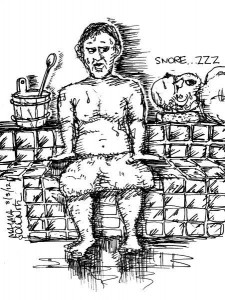 The Schvitz’s official name is the Mt. Pleasant Russian-Turkish Baths, which nobody uses. Some people call it the Bathhouse. Some people call it the Temple of the Holy Steam. (Attorney Harvey Kugelman does. Does anybody else?)
The Schvitz’s official name is the Mt. Pleasant Russian-Turkish Baths, which nobody uses. Some people call it the Bathhouse. Some people call it the Temple of the Holy Steam. (Attorney Harvey Kugelman does. Does anybody else?)
Most people call it The Schvitz. It has photos of Mussolini, Dayan and Patton on the walls. That’s it for decorations. (Plus a photo of Clint “Dirty Harry” Eastwood by the kitchen, reports Mike Madorsky.)
There are three acceptable responses to “Have you ever been to The Schvitz?”
a) I held my stag there.
b) I was there with my father.
c) My grandfather took me there.
The Big Five in Russian-Turkish–style schvitzes are in New York, Los Angeles, Detroit, Chicago and Cleveland. I got this list from Billy Buckholtz, the pleytse guy at the Cleveland schvitz. Billy’s grandfather was the original pleytse guy. (Pleytse is the rubdown, traditionally done with a broom of soaked oak leaves. Billy uses a seaweed broom and horsehair brush.)
Cleveland’s schvitz isn’t coed. Most of the other schvitzes are. The Detroit schvitz even used to have an orgy night. The Cleveland schvitz never went coed (aside from a short experiment in the 1970s) because the neighborhood is so bad. Why encourage women to come to Kinsman?
In The Schvitz’s heyday, it catered to immigrant factory workers who dropped by after work “to get the creosote off their skin, knock down a few shots and get a pleytse,” Billy said. “The immigrants didn’t want to wait in line with their eight kids for the only bathtub at their house.” Billy told me all this at a Yiddishe Cup gig at an art gallery. Not at The Schvitz.
I’m not crazy about steam.
I get periodic Schvitz invitations from the Brothers in Perspiration, an ad-hoc group of Cleveland Heights Jews. The email subject-line reads: “Have a serious jones for the stench of sweat, mildew, steak, cigar, garlic?”
That sounds good, except for the cigar, sweat, mildew and steam.
I’m due back at The Schvitz.
My bona fides. My bona fides . . .
—-
SIDE B
THE SCHVITZ (THE PLAY)
The Schvitz is a movie and a CD. Now it’s a one-minute play . . .
JIMMY, STAN AND KMETT are Cleveland cops at The Schvitz. They are in the boom-boom room (gas-passing room), lying on cots.
JIMMY, wearing only an Italian good-luck horn pendant: I used to work patrol with your son Pete in the Fifth.
STAN: That so? Where you now, Jimmy?
JIMMY: Downtown with homicide.
STAN: Pete is a meter maid in the Fourth.
JIMMY, pointing to another body: This is Walter Kmett. He’s with the detective bureau in the Third.
STAN: Did your father go to Latin?
KMETT: Collinwood.
STAN: I knew a Kmett at Latin.
KMETT: That’s my uncle.
STAN, sitting up and looking around: Is this cops-only night at The Schvitz?
JIMMY: Why? There are Jews here. A couple. I’m Jewish. They circumcise you right on the spot here. You’re next.
KMETT: They should have did Hitler.
JIMMY: Hitler was bad news.
KMETT: There are others. Ahmadinejad. Nobody says nothing.
STAN: The Israelis say “fuck you.”
BILLY THE PLEYTSE GUY walks in, waving his brush: Step right up. Twenty dollars for goys, twenty-five for Jews. I can do everything your wife can — everything for the last twenty years.
KMETT: Really, Billy? My wife and I have something magical going on.
BILLY THE PLEYTSE GUY: Such as?
KMETT: Tonight I’m making her disappear.
BILLY THE PLEYTSE GUY: What’s the admission charge?
KMETT: For you, twenty-five dollars. Where you been?
BILLY THE PLEYTSE GUY: I just got back from LA.
KMETT: Why there?
BILLY THE PLEYTSE GUY: My kids are out there.
KMETT: Nice.
BILLY THE PLEYTSE GUY: Not nice. California is one vast shithole. Everybody’s so casual there, it rubs off on the kids. What about you?
KMETT: I was down in Florida, visiting my dad. He sits on the toilet all day and reads about how to make a putt. That’s what they do down there. He got his pension — 66 percent. A shine tried to poke his eye out.
BILLY THE PLEYTSE GUY: Did you hear Ralph Friedman got 72 percent for a hangnail?
KMETT: Ralph is a scumbag. A hangnail?
JIMMY: He’s a slime bag.
KMETT: He’s the shit in the toilet.
BILLY THE PLEYTSE GUY: Ralph Friedman is my cousin.
KMETT: Your cousin? He’s still a slime bag.
STAN: Ralph is smart, I’ll grant you that. He was the Einstein of S.I.U.
KMETT: He’s a scumbag!
JIMMY: Ralphy the Alkie. He sampled more booze than Eliot Ness. Ralphy could smell booze a mile away.
STAN: He’s a goose.
BILLY THE PLEYSTE GUY: He’s not my cousin.
JIMMY: You schmuck, why’d you say he was your cousin? Where are the steaks?
KMETT: It smells in here.
BILLY THE PLEYSTE GUY: That’s garlic.
KMETT: That’s not garlic. This place is one vast shithole.
—
Ralph Solonitz’s illustrations, above, were in The Forward print edition, 3/16/12, and online, 3/7/12.
—–
Re: Kickstarter
I’m dubious of over-40-year-olds asking for money on Kickstarter.
My friend Mike got hit up by an old guy/ friend who was trying to raise $100,000 for a sculpture project. Mike said to me, “Let him get a job. What am I — his relative?”
Under 40, you can play Kickstarter.
Synth-player Jack Stratton and banjoist Rob Stenson are trying to raise $2,400 on Kickstarter. The young duo has 10 days left to reach its goal. They are more than halfway there, with $1243 and 70 backers.
Kickstarter chose the Stenson-Stratton project as a pick-of-the-week. The project video (below) features Jack as a German. Kickstarter co-founder Yancey Strickler wrote, “These guys make the best/weirdest projects.” (Helps if you’re under 40 — like Strickler and his Kickstarter crew — to fully appreciate the vid and work.)
Watch the video, then click here to donate.
May 23, 2012 8 Comments
THE SILVER FOX / THE CREEP
Charlie Broeckel was the Silver Fox or The Creep. He went by both names. He was a burglar and hit-man in Collinwood –- a neighborhood in northeast Cleveland.
I’m not sure where Broeckel is now. Maybe he’s dead. Or maybe he’s in a safe house in Ada, Oklahoma. For a while he was “John Bradford” (federally protected) in the Pacific Northwest.
Broeckel and Phil Christopher — another Collinwood burglar — did a bank heist at Laguna Niguel, California, in 1972. It was supposedly the biggest bank burglary of all time. Charlie and Phil flew to California from Cleveland for the job. California didn’t have quality bank burglars back then, I guess. Collinwood did.
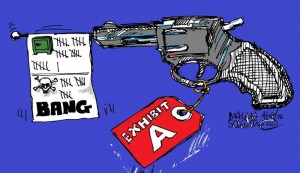 I saw Broeckel and Christopher at trials in Cleveland. They would periodically come in from their federal prison cells or witness protection program locations. One trial was for murder: Christopher and accomplices took a pimp, Arnie Prunella, out on a boat, shot him and drown him.
I saw Broeckel and Christopher at trials in Cleveland. They would periodically come in from their federal prison cells or witness protection program locations. One trial was for murder: Christopher and accomplices took a pimp, Arnie Prunella, out on a boat, shot him and drown him.
Collinwood was “think ethnic”-to-the-10th power. There were four distinct neighborhoods in Collinwood: Slovenian (St. Mary’s parish), Italian (Holy Redeemer), black (west of the E. 152nd Street, aka the DMZ) and Lithuanian (Our Lady of Perpetual Help). Broeckel’s ethnicity was indeterminate. Maybe German, maybe Slovenian. Christopher was Italian.
Broeckel and his fellow burglars stored nitroglycerin — used for blowing up safes — on a Lake Erie beach. In 1983 a Cleveland policeman operated a backhoe at the local beach, searching for old, very unstable nitro. Traffic cops kept reporters and passersby at a distance. Charlie was supposedly in bad health and wanted brownie points for helping the cops find old explosives.
The chief cop in the neighborhood — Capt. Ed Kovacic — had a warm spot for highly skilled crooks. These thieves would drill out safes and jump burglar alarms. They weren’t entirely stupid. Kovacic often said, “If there was a hall of fame for burglars and safecrackers, it would be in Collinwood.”
In 2006, Lyndhurst police chief Rick Porrello wrote a book, Superthief, about Christopher. Then Tommy Reid, a Hollywood entrepreneur, made a documentary movie –- also Superthief — which came out in March. The movie is mostly talking heads: old cops and old thieves sitting in living rooms, reminiscing about old days.
The documentary ran exclusively in theaters in Euclid and Lake County — where many former Collinwood residents moved to. There were three people in the Lakeshore Cinema. One elderly man, with a walker, said on his way out, “Phil is a thief!” His wife said, “I like Phil!”
Christopher, 66, is out of jail. He has spent nearly half his life in prison. What if Broeckel — the creep, the silver fox, the rat — comes out of hiding and puts Christopher back in prison?
Just like old times.
—
I was a police reporter in Collinwood for Sun Newspapers in the 1980s. (Last time I’m going to mention this factoid for a while. So please remember.)
—-
SIDE B
Here is the annual “inside baseball” post. Your name might be in here . . .
NAMING NAMES
We interrupt this blog to tell you this blog is three years old.
“I’ve read every word of your blog!” a musician told me.
Hooray for him. I wrote every word.
A blog reader said, “You found your subject — your father, Toby.”
No, you did. I’ve had Toby on the brain for decades.
A woman said, “I look forward to your posts every Wednesday morning . . . I don’t do comments.”
Here’s my comment: Nine-tenths of Klezmer Guy readers don’t do comments. They want to protect their animosity. Listen, you are not above comments; you are not paying for this; chip in the occasional enlightening, humorous or really stupid comment.
Several other readers claim to have read every word of the blog.
What was the first word?
Special thanks to our major donors (commenters). I could have done it without you, but it wouldn’t have been as much fun.
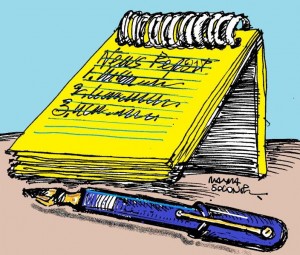 In no particular order, thanks to Marc Adler, Jessica Schreiber, Gerald Ross, Seth Marks, Ted, Adrianne Greenbaum, Bill Jones, Mark Schilling, Harvey Kugelman, Ellen, Susan Greene . . .
In no particular order, thanks to Marc Adler, Jessica Schreiber, Gerald Ross, Seth Marks, Ted, Adrianne Greenbaum, Bill Jones, Mark Schilling, Harvey Kugelman, Ellen, Susan Greene . . .
David, Margie, Irwin Weinberger, Jane Lassar, Zach Kurtz, Alice Stratton, Alan Douglass, Steve, Jack, Don Friedman, Kenny G, Steven Greenman . . .
Charlie B, Don Edwards, Garry Kanter, Jack V, Ari Davidow, Emilie, B Katz and Richard Grayson.
Get your name on this list next year by contributing at least $2,500 or writing comments.
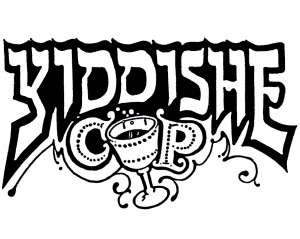 Special thanks to Ralph Solonitz, the blog’s illustrator. He adds a lot. I encourage him to throw in as many pics as possible. Works out well. Ralph had a Klezmer Guy illustration in The Forward recently.
Special thanks to Ralph Solonitz, the blog’s illustrator. He adds a lot. I encourage him to throw in as many pics as possible. Works out well. Ralph had a Klezmer Guy illustration in The Forward recently.
I met Ralph about 21 years ago when he designed Yiddishe Cup’s logo. That’s still your best logo, Ralph.
Sometimes I send my stories to the media before posting here. This past year Klezmer Guy articles were published throughout the planet: the International Herald Tribune, New York Times, City Journal, Ann Arbor Observer, Cleveland Plain Dealer, Jerusalem Post. Did I miss any continent? I’ve started to link to some of the newspaper articles. Please see the right side of this blog, under “Articles.” Also, check out “Categories” there. “Categories” is particularly useful if you want to read 68 posts in a row about real estate.
Google Analytics — a spy op — says there are Klezmer Guy readers in every state and many foreign countries. Ohio has the most Klezmer Guy readers, followed by New York, California, Michigan and Massachusetts. The top foreign countries are Canada, United Kingdom, Israel, Germany and Australia.
Google Analytics, for your information, zeroes in on readers by their hometowns, not their names. For instance, somebody in Chico, California, reads this blog.
The bell rings, round four.
—-
I wrote this op-ed, “The Impossible Dream,” for Mother’s Day for the Cleveland Plain Dealer (5/13/12). It’s about listening to the radio with my mother.
Illustration by Ted Crow, Plain Dealer
May 16, 2012 10 Comments
THANK GOD I’M SLOVENIAN
The sign at the McDonald’s on Lake Shore Boulevard read: 30-minute time limit while consuming food. The manager must enforce these rules. Your cooperation is appreciated.
Several retired cops sat beneath the sign, drinking coffee all morning.
Ex-cop Bill Tofant said to me, “I used to work out every day at the YMCA. You know what that stands for? The Yiddishe Meat Cutters Union.”
I didn’t know that. (I was with retired cops because I was a police reporter in the 1980s.)
“I can still run a mile at 73 and hold my own in fisticuffs, and I can turn my head to see if traffic is coming,” Tofant said.
Tofant liked me — or put up with me — because my Great Uncle Itchy Seiger had owned a deli on Kinsman Road, which all the cops used to eat at. “Your uncle would throw his arms around me every time I came into the restaurant,” Tofant said. “I couldn’t spend a nickel there. They had corned beef, turkey, you name it, gherkin pickles.”
The cops at McDonald’s decided to rate pawnbrokers — most of whom were “good sharpYidls.”
I knew one of the Yidls: Larry Botnick of Euclid Loan at East 59th and Euclid. Larry had played tennis with my father. Larry got shot and killed in a stick-up. A couple streets over, there had been another stick-up . . .
“Three colored guys went in back of East 63rd and St. Clair,” said Bill Lonchar, an ex-cop. “One guy had a horse pistol yea long. It stuck out like a sore thumb. It was a military weapon.”
Re: the pawnbroker at East 79th and Hough . . . 1.) not shot at, and 2.) “not so good.” “He would buy a stove [gun] that was red hot and smile.”
The cops rated Italian. Not pawnbrokers. Burglars. Hardly worth talking about. “If you’re not Italian, you’re nobody. All that goddamn bullshit. All that Italian camaraderie bullshit.”
The Lithuanians were worth talking about. “The Lits will eat soup for twenty years, three times a day, and save their money, and all of a sudden they buy apartment buildings,” Lonchar said.
The Irish: dunderheads.
The blacks: no comment.
 The Slovenians: “Very respectable.” Top of the line. “There was a safecracker, Charlie Broeckel,” Lonchar said. “He went out to Laguna Niguel, California, and hit a bank there. Burned [spent] seven-mill worth of shit in negotiable papers. Charlie always found his way out. He might have been German, not Slovenian, actually. His mother held a very respectable job. She was beyond reproach, nothing like a stumblebum. The Broeckels lived at 8815 St. Clair.”
The Slovenians: “Very respectable.” Top of the line. “There was a safecracker, Charlie Broeckel,” Lonchar said. “He went out to Laguna Niguel, California, and hit a bank there. Burned [spent] seven-mill worth of shit in negotiable papers. Charlie always found his way out. He might have been German, not Slovenian, actually. His mother held a very respectable job. She was beyond reproach, nothing like a stumblebum. The Broeckels lived at 8815 St. Clair.”
Put up a plaque. Lonchar was Slovenian. [So were the district police commander, the ward councilman and the mayor, Voinovich. All lived within a mile of McDonald’s. (Voinovich was half Slovenian, half Serbian. Good enough.)]
—–
Footnote: “Thank God I’m Slovenian” was a popular bumper sticker in Cleveland in the 1980s. Cleveland has more Slovenian immigrants than any American city.
The top-selling ethnic bumper stickers in Cleveland were “Thank God I’m Polish” and “Thank God I’m Irish.” I know, I interviewed the bumper-sticker maker in Broadview Heights. Special-order: “Thank God I’m Transylvanian Saxon.” No market: “Thank God I’m Jewish.”
Check out this vid, Who’s Cheaper: Slovenians or Lithuanians?
January 4, 2012 1 Comment
